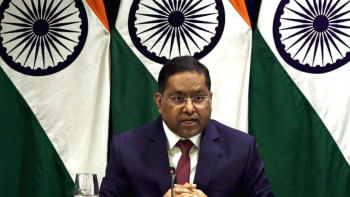An Ode to Arundhati Roy

Whenever I think of Arundhati Roy, I am reminded of afternoons on the rooftop with soothing breeze and neighbourhood pigeons circling the sky. I recall my time last year when I didn't have to deal with as much pressure as I have to now. As the sun beat down, having the whole neighbourhood awash in its glow, I would head out to the rooftop with one of her novels and entangled earphones in hand. I would be slowly pulled in to the pages while Kerala and a busy Delhi neighbourhood sprouted around me. What seemed like mere words at first would soon form a web, and solidify into scenes with people, riots, and emotions in them. Such is the power of words. They can form walls, skies, mountains, happiness, and sadness.
Ever since I was introduced to Arundhati Roy, I have wanted to read more and more of her works—both fiction and non-fiction. Even her non fictional works carry a fictional storytelling that flows like water through the jungles of central India, disputed rural areas (big corporations VS the people), uprooted villages, and of course, Kashmir. My favourite non-fiction (an essay) by her is 'Walking with the Comrades,' which I found in The Outlook India. In the very first image, she can be seen sitting on the bark of a fallen tree, with a red gamcha over her head and some rebels wearing khaki clothes. She is looking into their eyes in a pensive manner as she keeps her notebook and pen ready. The words spilling from their mouths would soon find themselves printed in the essay. Their stories would finally be out in the open. My love for the author has increased so much after I discovered that she has spent time with rebels in the forests, villagers affected by the dams. She interviewed them for her work, which truly reflects her concerns for the downsides of capitalism and its victims — the earth, the indigenous people. She does not hesitate to speak against the popular figures that are held high by the mass, showing the readers their fault-lines. If I never had the urge to read her essays online, I would never know of those crucial issues that threaten the people and the environment and yet fail to make the news. Despite her loud narratives often landing her in trouble, she never gave in. She reminds me of that one kid in class who will tell the truth irrespective of the scornful looks.
I had once asked a friend, "Name a book that changed your life." She had replied, God of Small Things. It was my first ever Arundhati Roy book. Probably, I would never read her works if it weren't for that friend of mine. What started as a slow paced reading soon turned into a literary discovery. I was quite new to reading back then. So I used to dislike the book for its descriptive features which would make it too slow for my then self. Who would have thought that I'd end up being someone who re-reads some chapters to this day and never gets bored? I still associate 'Ayemenem' to a hot weather when the fan cannot work its charm and the sun makes it difficult to look up into the sky. It is probably because of how the book starts, "It was a hot, brooding month in Ayemenem..." The fact that this language could be used so creatively surely tops the list. The sentence structures, the metaphors, the original techniques, they have taught me a lot about going beyond limits while writing. Here is an example of how she layers a matter with her own creative touch. "The sky was thick with TV. If you wore special glasses you could see them spinning through the sky among the bats and homing birds—blondes, wars, famines, football, food shows, coups d'état, hairstyles stiff with hair spray. Designer pectorals. Gliding towards Ayemenem like skydivers. Making patterns in the sky. Wheels. Windmills. Flowers blooming and unblooming."
After her semi-autobiographical The God of Small Things won her the Man Booker Prize in 1997, it took her some 20 years to publish another book of fiction and take place on the long-list yet again. Like the previous novel, it was nothing short of creativity and learning materials. For instance, it has given me glimpses of lives of the marginalized people, of tensions in the borders, of riots that divide a country, and of dicoflenac that kills vultures. The pensive beginning kept me hooked to the book despite the fact that I usually cannot contain too much sadness. It was because of the writing, I am sure. No matter the content, I would never ignore her writing. I think I am still captivated, pardon me if I sound mad.
Once being asked if she believed writing was the most powerful way to resist, she said, "I believe in the biodiversity of resistance. Some write, some fight, some fast, some march, some sing…Why should there be only one way?" There is a unique charm to her replies. One should read more of her interviews to see the eloquent replies she comes up with at the drop of a hat. In an interview on The Guardian, she says, "...So being unreasonable is the only way that we can have hope..." In many ways than one, this is very relatable. I don't remember the last time I didn't derive hope from 'unreasonable' things when I was in dire need of consolation.
Arundhati Roy is a kind of person who shows readers the obvious facts, but in a poetic, beautiful, and rebellious manner. Even though many despise her works, her voice is important for this generation because of its beauty tinged with defiance.
The writer is currently a 12th grader in Birshreshtha Noor Mohammad Public College.


 For all latest news, follow The Daily Star's Google News channel.
For all latest news, follow The Daily Star's Google News channel. 



Comments